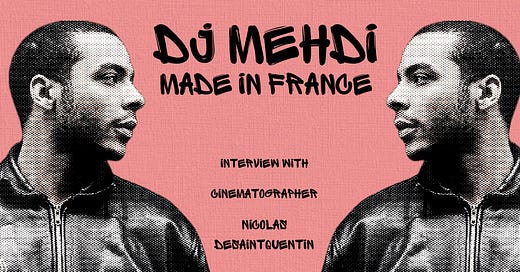DJ Mehdi Made In France : Interview with the documentary's cinematographer Nicolas Desaintquentin
On the creative direction of the documentary series
Two months, DJ Mehdi made in France, a docu-series (Film documentary) streamed on Arte’s platform and their YouTube channel. Directed by Thibault Delongeville, a documentary filmmaker, paying homage to his late best friend, DJ and beat maker, Mehdi Faveris Essadi. The six episodes film documentary isn't itself biographical or musical only but rather a “thriller documentary”, put by Thibault himself.
From the camera choices, to the editing, to the way they incorporated personal archives, to the reconstituted scenes of how music was produced by DJ Mehdi, and his evolution as a beat maker, Thibault Delongeville and his team ended up creating a six episodes film documentary that is educational, stimulating and culturally impactful.
Besides, by putting his team in that creative direction, Thibault showcased— in an unintentional way— that job positions like : Archivist, cinematographer, editor in the context of film documentary making are as important as in the film making one. For that matter, I've asked the documentary’s cinematographer Nicolas Desaintquentin few questions about how they created this latter.
The full interview
When Thibault Delongeville (director) first approached you for this project, what was the creative direction you both decided to take for this documentary series? What notes did Thibault give you for the global creative vision, at first?
When we started producing the documentary series Dj Mehdi, the idea was to make a film that would meet the aesthetic criteria of streamers such as Netflix or Disney. From the start, we wanted to make a film about a musician that would be as musical as possible in its content but also in its formal approach.
As a cinematographer, your job consists of making artistic and technical choices for the camera, film stock, etc. What choices in terms of lenses, filters and camera did you make?
The idea for the documentary ivolves finding an optical/camera combination that could render the most beautiful textures possible on the skins but also in the blurred backgrounds on the sets and possible objects placed behind our characters. We started by doing comparative tests and quite quickly our choice fell on the Alexa mini lF combined with Blackwing tribe 7s.
From a cinematography point of view, you used many visual languages according to Thibault, by combining filming in digital, filming with 16 mm, Super 8 mm. Why use these different formats? Did you want to reflect the different eras/stages that Mehdi went through as an artist?
Once the main interviews were filmed, we spent a lot of time making machine shots, moments of life. Our desire to sometimes recreate false archives (period documentaries, family films) led us to use super 16/8 on a few occasions. The idea was to be able to make the archives coexist with recent images, thereby bringing together eras. Dj Mehdi's work has always been to create links between communities, between musical genres but also between eras. Paying tribute to him also consisted in bringing the archives to life in the present. As a way of perpetuating his work which still resonates today in the hearts and works of many contemporary artists.
In terms of lighting, we can see an entire color scheme used throughout each episode. Can you explain the lighting color scheme choice?
The idea was to do the most accurate possible. The most coherent and sensitive too. Against advertising imagery, and for political reasons I also tried not to overuse colors on black skin, even though black skin lends itself perfectly to it. Refusal of exoticism, and also to mark an equality of treatment. The colorist Kevin Stragliati then prepared half a dozen LuTs (look up the tables) for us to play with on set.
On the different reconstructed scenes, whether those with DJ Mehdi’s own music machines (MPC, Keyboard, mixing table) and vinyls, or those deconstructing his music production process in a studio. Did you face any challenges filming these scenes?
For the machine shots, the writing moments, we proceeded by trying to always be a little abstract, not too literal. These shots must allow the viewer to immerse themselves in a form of reverie. Nothing was complicated because we gave ourselves the time to do it well and we had a superb optical camera setup.
You went above and beyond filming these reconstituted scenes with your entire team under the direction of Thibault. What particular scene that stood with us is the 113 album vinyl pressing scene that we heard you filmed in an actual factory! How did you do that with Thibault?
Last question is Alex Silberman my co dop answering as he shot the vinyls factory
As Artistic Director, Thibaut has been involved in the creation of many iconic French rap album covers, notably those produced by DJ Mehdi. He collected an enormous amount of archive material, and set out on the principle of reconstituting as much as possible of what he didn't have, in order to retain the incarnation of Mehdi. This is what makes the documentary so rich. For the Vinyl press, Thibaut recovered all his old files, which he'd worked on himself, and rented a factory on the outskirts of Paris in order to relaunch the record and sleeve factory himself as if it were a real release. We kept to the same photo direction, with assertive colored atmospheres and lots of shimmer. Combined with the metallic atmosphere of the place and the automation of the machines, this gave a very Music Video vibe from this period, early 2000s.
Poster and interview by Yamina.H
Photo credit Getty Images.




